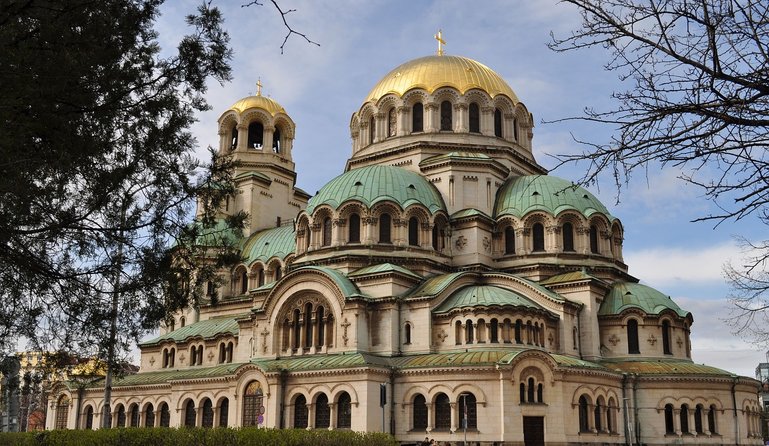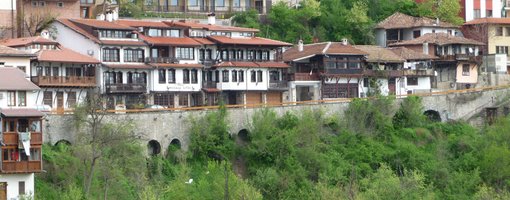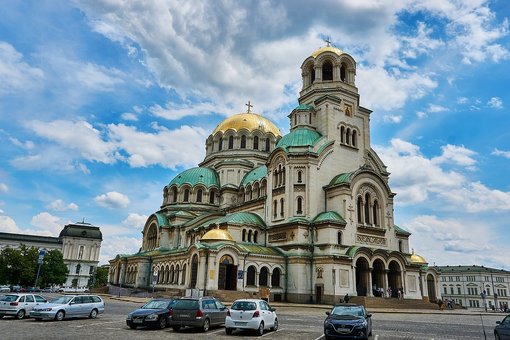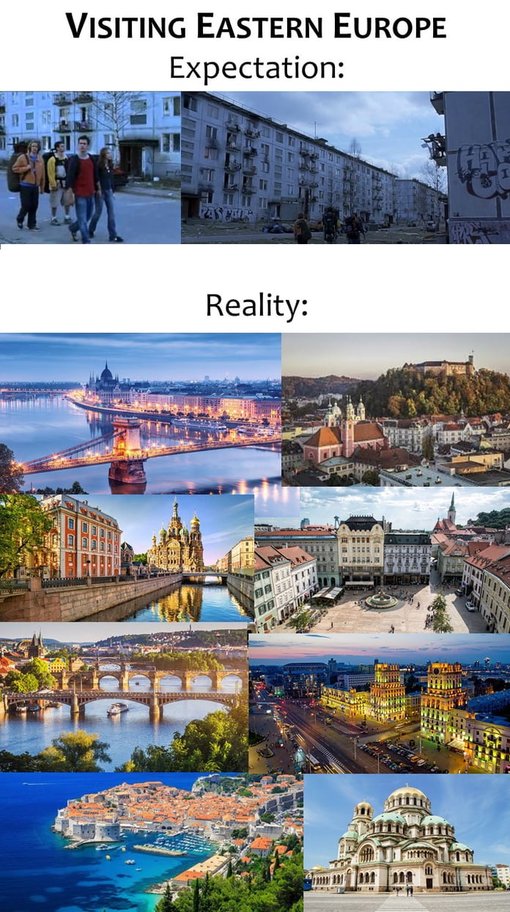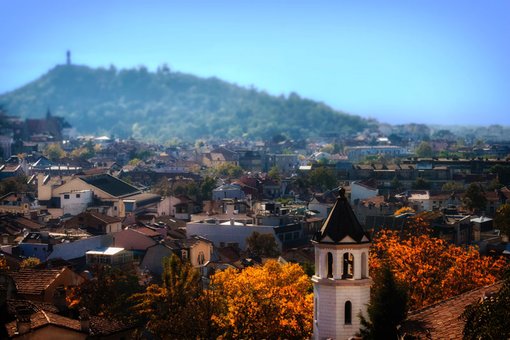I spent 4 days in Sofia; the first day and the last day were also the days of Arrival and Departure so most things I saw in 2 days with the Jute of two tours. The free walking tour and the Communist tour that I highly recommend.
17 BEST THINGS TO DO IN SOFIA
1. St. Alexander Nevski Cathedral
Number one tourist attraction and impossible not to visit St. Alexander Nevski Cathedral. This beautiful Orthodox cathedral is the biggest of all Bulgaria and one of the tenth the biggest churches in all Eastern. The first stone of the cathedral was put in 1882 but it was built around 1904 - 1912 in neo-byzantine style with material arrived from all over Europe. The church is dedicated, as the name says, to Alexander Nevski and to all the soldiers (Russians, Bulgarian, Ukrainian and Belorussian) that set Bulgarian free from the Ottoman in the Russian-Turkey war. The church in white, gold and green roofs is the top attraction to visit in the Bulgarian capital.
2. St. Sofia Church
Right in front of the largest Orthodox church is St. Sofia Church. The church of St. Sophia is the second oldest in Sofia; it dates back to the 6th century and was built by the Byzantines. Originally a Christian church, it was later converted into a mosque by the Ottomans and today it is an Orthodox church where you can still see the remains of previous buildings. This church is special for one thing: it gave its name to the Bulgarian capital. At that time there were many pilgrims who came to Hagia Sophia and after a while, people began to call the city, which actually was called Serdica, Sofia instead of just calling the church. It was then decided to change the name of the city.
3. The Church of Saint Nicholas
From the Cathedral of Alexander on foot to the main street of the capital we can find the Church of Saint Nicholas also called the Russian Church. The site was built after 1882 by the Russians and was used as the church of the Russian embassy, which was located next door, to from the entire Russian community to Sofia. The church is named after the Emperor of the time in Russia, Nicholas II. When the emperor died near his sarcophagus, he was placed a box to fulfill his wishes. Even today people write and post wishes on the box hoping that Nicholas will grant them.
4. Ivan Vazon National Theatre
The first thing that I saw on my first day in Sofia was the Ivan Vazon National Theater. This beautiful theatre is situated inside the Garden City and in front of it, a fountain with water games. It was founded in 1904 and was called like the famous writer Ivan Vazon that was also the first one to exhibit in the theatre. The theatre was rebuilt after the Second World War and again in 2006, with the last renovations has been added a lot of gold.
5. St. George Rotunda
Situated inside a courtyard near the Presidency Palace we can find St. George Rotunda. St.George church is the oldest intact building in Sofia. It dates back around the 4th century with the Roman Empire in particular with the emperor Constantine The Great that loved Sofia to the point that he said “Serdica, that is my Rome”. The church originally was the private bath of the Emperor, you can still see the ingenious mechanism with canals to pass the water built by the Romans; the church was then converted to a Baptistery when Constantine declares Christianity as the only religion and finally to a church. Today St.George Rotunda belongs to the Orthodox church.
6. Presidential Palace
Since we are in San Giorgio the next stop must be the Presidential Palace. The history of the President of the Republic, in Sofia, is quite recent; its institutions began in 1991. The President is the head of the country and has only powers of representation as there is the President of the Council. Very interesting the change of guard that happens every hour.
7. Indipendence Square
In the heart of Sofia, we find, covered with a yellow cobblestone, Independence Square that houses among other things the Largo. The Largo is a set of three buildings built during communism. At that time much of Sofia was destroyed by World War II bombs and in 1952 it was decided to build the Largo; in just five years everything was over. These buildings are used today as offices of the President, Ministry Council and the National Assembly.
8. Roman Ruins
Funny anecdote. When I arrived in downtown Sofia I was walking to reach the hotel, but it took me 10 minutes just to figure out how to cross the street. I know it sounds stupid, but there were no pedestrian crossings to cross, and, yes, there were some stairs to go underground, but I always thought it was for the subway. Wrong, really wrong! Sofia has another underground city! Not only can you cross the street underground and take the subway there are also shops and even a Mcdonald's. Not to mention the town of Serdica. For example under Independence Square, there are ruins of a Roman fortress from the 4th century. The ruins are also visible from some large oval windows that are on the square.
9. St. Sophia Statue
Do you remember that I told you that today there is another statue instead of the statue of Lenin? Here we are! In 2000 it was decided to hoist a statue of St. Sophia as a gift for the new millennium. The statue was made in bronze by the sculptor Georgi Chapkanov and is 8 meters high.
The statue of Saint Sophia was much criticized by the population and the church as it was represented in a very sensual and feminine way, not really suitable for a saint, as you can see.
10. Tolerance Square
My favorite place of all Sofia! Bulgarians are really proud of this square and call it Tolerance Square. There are 2 main reasons why I really like this square.
First of all, during the construction of the tube were discovered some ruins and in this square just a few steps apart you can see ruins of the Roman century, the 14th century with the Second Bulgarian Empire and the palaces of the 20th century.
Second, I think this is the only place in all Europe where you can see an Orthodox Church, a Mosque, a Catholic Church and a Synagogue (and a McDonalds) all sharing the same space just a couple of feet from each other. Is this not amazing? We can all learn that despite your religion we are all here together in the same world.
11. Hot water good for your budy
Just behind the Square of Tolerance, we can find about twenty taps (maybe more) where water comes out for the whole day. Apparently, they are hot and smelly water sources (because of sulfur). This water would be very good for the body as it is of volcanic origin and contains many minerals. It's normal to see people fill their pitchers with this water and take a bus home.
12. Central Public Mineral Baths
The huge yellow building next to the water taps housed the Central Public Mineral Baths. The bathrooms were divided between men and women because they used them completely naked. Five years ago it was decided to turn it into a natural museum since no one has used the bath.
13. Vitosha Boulevard
Vitosha Boulevard is the main street of Sofia. It is a pedestrian street with restaurants and shops. Vitosha Boulevard starts from the Palace of Justice and goes up to South Park. It is the perfect place to relax with a beer.
14. Yuzhen Park
We walk from Vitosha Boulevard to South Park. South Park (or Yuzhen Park) is huge and has several interesting things about communism. First of all, it is impossible not to see the huge palace in front of a large fountain. The National Palace of Culture was built by the daughter of the communist leader, Todor Zhivkov to celebrate 30 years of communism in 1981. It is the largest multifunctional center for conferences and exhibitions in south-eastern Europe, today not much used because too large, 11 floors 5 underground and 6 higher, and very expensive.
15. Commemoration Chapel
We are still in South Park and we can find to commemorate the Bulgarians who died during the regime a small chapel and a black wall with the names of all people that died.
16. Berlin Wall in Sofia
Do you know that there is a piece of the Berlin wall in Sofia? Very strange since I went to Berlin only 3 weeks before leaving for Sofia. The piece of the wall was donated to Bulgaria at the end of communism as a symbol and it is possible to see it today in a corner of the park surrounded by trees.
17. The Soviet Army Monument
Another controversial monument is the Monument to the Soviet Army. Controversial because it represents the Russian soldiers who liberated the Bulgarians during World War II. This monument is today the place where many protests take part and it is curious as since 2011 it has been painted several times; The first time someone painted Russian soldiers as superheroes two years later the monument was painted in pink and the last time in 2014 was painted as the Ukrainian flag. Each time an association called "friends of the Russians" cleaned up the monument until they installed the cameras.
